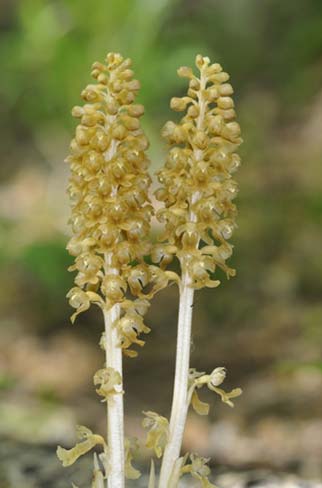Bird’s-nest orchid (Neottia nidus-avis)
When: June - July
How many: Very scarce

(image courtesy of dreamtimes.com)
The orchid family rarely fails to surprise. Some have flowers that mimic insects, whilst others, maybe all of them, depend for successful growth on an association with soil-based fungi.
Then there is the bird’s-nest orchid, a plant parasite that takes absolutely all its nutrients from a fungal partner. These orchids have no green parts, lack chlorophyll, and cannot photosynthesise. Conventional roots are also absent, so neither can they take water and nutrients from the soil. The relationship is thought to be one-sided, in-so-much as the orchid provides nothing in return.
Consequently, bird’s-nest orchids can, and usually do, live in the darkest, most shaded beech woods, and occasionally woods of oak, ash or hazel. Here, the fungi absorb nutrients from the often deep leaf litter, humus and other dead and decaying organic material, and pass on at least some of the benefits to the orchids.
But what an odd name, for the above-ground portion bears no resemblance to a bird’s nest. It is, though, the thick, branching, lobed, fleshy, fungus infested root system from which the name derives.
Most common on the chalk of central Hampshire, this orchid is also infrequently found in the New Forest.
Not surprisingly, it is a distinctive plant. Pale brown in colour, it grows to 10-40 centimetres (4-16 inches) high. Flowers in cylindrical spikes appear in June and July, whilst the leaves are reduced to small, brown, sheathing scales.
References:
Wild Orchids of Hampshire and the Isle of Wight: Martin N. Jenkinson
The Flora of Hampshire: Anne Brewis, Paul Bowman and Francis Rose
Collins New Generation Guide - Wild Flowers of Britain and Northern Europe: Alastair Fitter
Reader’s Digest Field Guide to the Wild Flowers of Britain
The Encyclopedia of British Wild Flowers: John Akeroyd
More links
Other related links
Search this site

Sadly, 58 animals were killed - 35 ponies, 13 cows, 8 donkeys and 2 sheep, whilst a further 32 were injured - 3 pigs, 9 donkeys, 11 cows and 9 ponies.
(Forty-three accidents occurred in daylight, 15 at twilight and 101 in the dark. Twenty-seven accidents were not reported by the driver involved).
Here's just one horrific example - Three donkeys killed in collision with van at notorious New Forest blackspot (Advertiser and Times)

